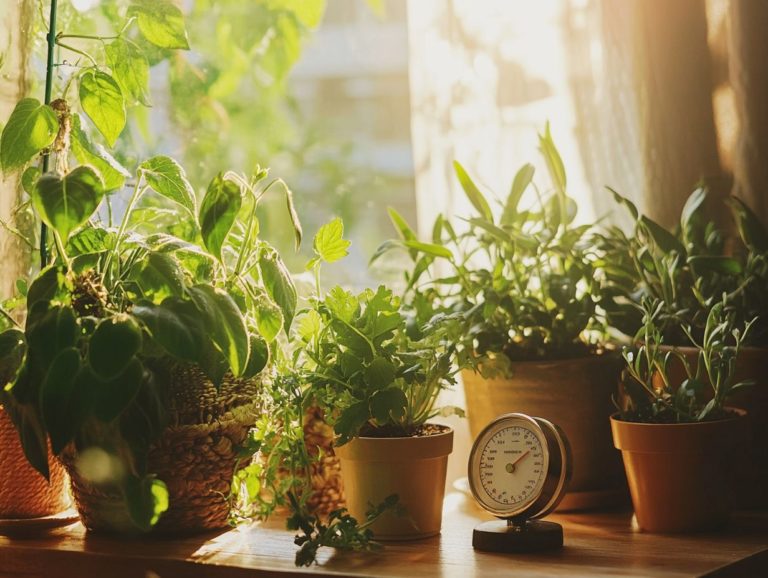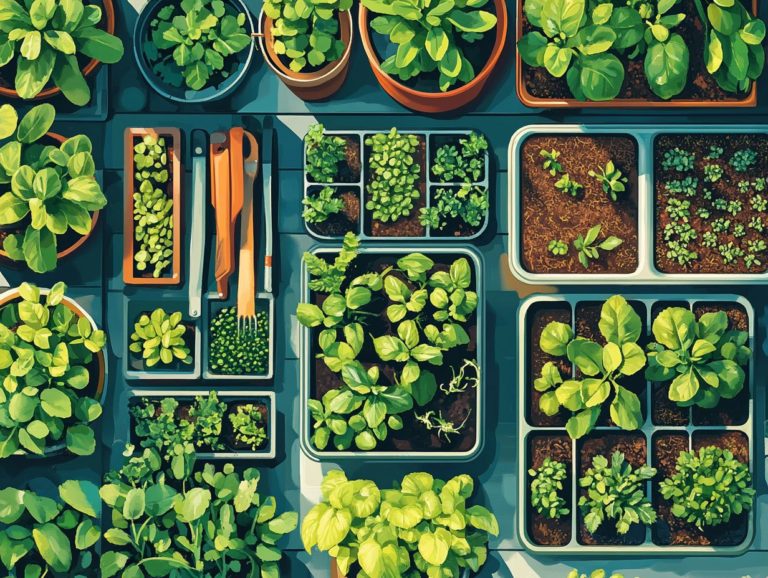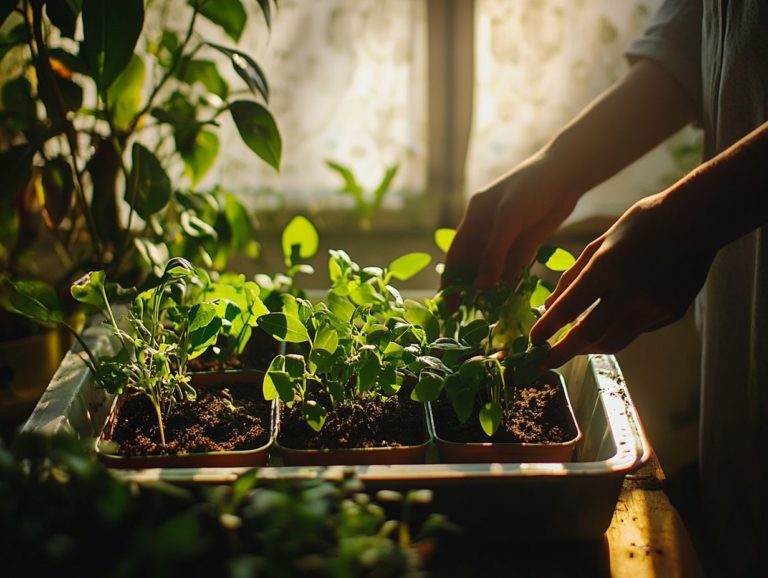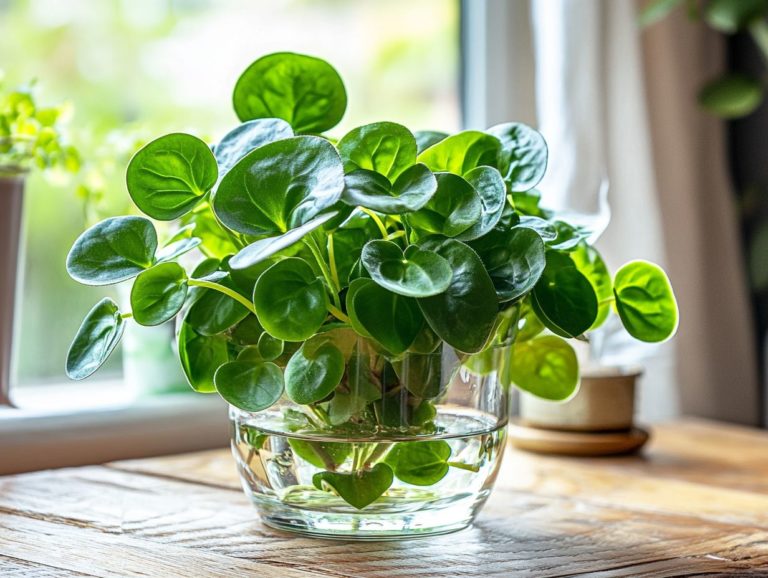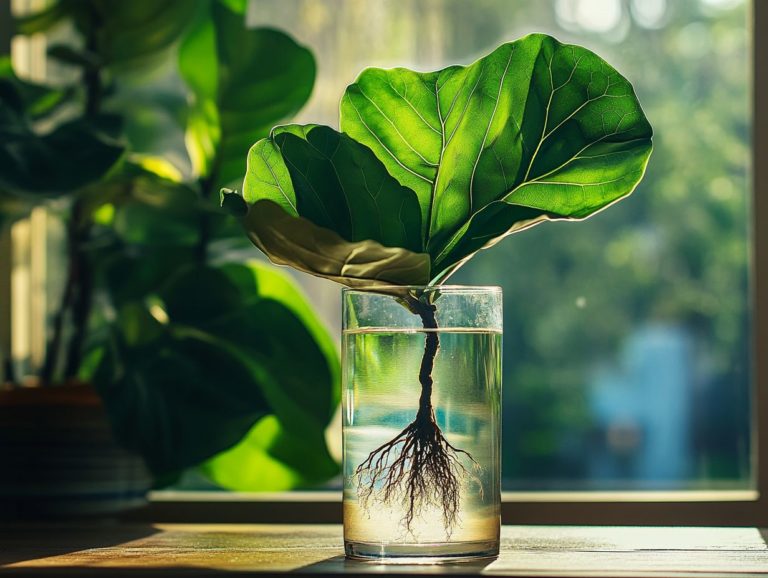How to Propagate Graptopetalum Plants
If you’re aiming to expand your collection of Graptopetalum plants or share these stunning succulents with friends, mastering propagation is essential.
This guide will lead you through various methods, including leaf cuttings, stem cuttings, and offsets. You’ll find everything you need, from preparing the right supplies and timing to step-by-step instructions for each propagation technique.
You will discover crucial care tips for your newly propagated plants and how to troubleshoot common issues that may arise.
Jump in and start growing your new plants today!
Contents
- Key Takeaways:
- Methods of Propagation
- Preparing for Propagation
- Step-by-Step Guide to Propagation
- Caring for Newly Propagated Graptopetalum Plants
- Troubleshooting Common Issues
- Frequently Asked Questions
- What is the best time of year to propagate Graptopetalum plants?
- What is the easiest method for propagating Graptopetalum plants?
- Can Graptopetalum plants be propagated from leaves?
- How long does it take for Graptopetalum cuttings to root?
- Should I use rooting hormone when propagating Graptopetalum plants?
- Can Graptopetalum plants be propagated in water?
Key Takeaways:

- Propagate Graptopetalum plants through leaf cuttings, stem cuttings, or offsets. Each method requires specific preparation and care to ensure successful propagation.
- Timing and ideal conditions are crucial for successful propagation. Have the right supplies and tools on hand and provide appropriate care during the process.
- Care for newly propagated Graptopetalum plants by transplanting and maintaining them properly. Troubleshoot common issues such as root rot or wilting to ensure healthy growth.
Overview of Plant Characteristics
The Graptopetalum, or Ghost Plant, is a striking succulent that thrives in the arid landscapes of Central Mexico and the Chihuahuan Desert. Picture this: stunning rosettes of pale, glossy leaves that not only catch the eye but also store moisture, giving them both aesthetic and functional appeal in your indoor and outdoor spaces.
With its small yellow flowers and remarkable drought resistance, this plant is a go-to for plant enthusiasts and gardeners seeking a touch of elegance without the hassle.
These qualities make it the perfect choice for anyone in search of low-maintenance greenery. For instance, the Graptopetalum paraguayense has silvery leaves, while the Graptopetalum amethystinum is renowned for its rich, purple hues. If you’re interested in expanding your plant collection, learning how to propagate spider plants can be a rewarding endeavor. Each species in this captivating genus offers something unique.
For optimal growth, these beauties thrive in well-draining soil and bask in bright, indirect sunlight. Their most vibrant blooms appear during the warmer months.
Interestingly, some varieties have been celebrated for their healing properties and were historically used in remedies for skin ailments and other medicinal applications. This showcases their value that extends far beyond mere decoration.
Methods of Propagation
Propagation methods for Graptopetalum are wonderfully diverse, allowing you to propagate these stunning succulents through various techniques such as leaf cuttings, stem cuttings, and offsets or pups. Each method caters to different conditions and preferences, providing a rewarding succulent journey for both novice and experienced gardeners.
Leaf Cuttings
Leaf cuttings offer a highly effective method for propagating Graptopetalum. You can cultivate new plants from the succulent’s robust leaves provided you allow air to reach the soil and ensure well-draining soil.
Begin by selecting the healthiest leaves, those that are plump and free from any blemishes or pests. These characteristics significantly enhance the prospects for successful growth. Once you’ve carefully detached the leaves, rest them in a dry, shaded area for a day or two. This pause is essential for forming a callous over the cut end, which safeguards against rot during the rooting process. For detailed instructions, check out this guide on how to propagate jade plants effectively.
When you’re ready, place the cuttings atop a well-draining soil mix, ideally composed of potting soil blended with sand or perlite. During this critical period, avoid over-watering; letting the soil dry out between watering sessions will foster healthier roots. Additionally, position the cuttings in a spot that receives bright, indirect light to enhance their chances of thriving. For detailed instructions, check out this guide on how to propagate Monstera plants during this delicate propagation phase.
Start your propagation journey today and enjoy the beauty of Graptopetalum in your home!
Stem Cuttings
Stem cuttings present an exceptional method for propagating Graptopetalum. You can utilize sections of the stem to cultivate new plants. The key lies in understanding the optimal environmental conditions and potting requirements.
To embark on this journey, selecting the right portion of the stem is essential. Seek out healthy, firm stems free from any signs of disease or damage. Armed with clean, sharp scissors or pruning shears, make a precise cut just below a node. For detailed instructions on this process, check out our guide on how to propagate sansevieria plants. This is where new roots will sprout.
After cutting, let the cut edges heal for a day or two. This step helps prevent rot when you pot them. When you re ready to pot, opt for well-draining soil ideally, a cactus or succulent mix. Position the cuttings in a bright spot that receives ample sunlight, avoiding direct, harsh rays initially to prevent shocking the plant.
Check the moisture levels regularly. Keeping the soil slightly damp fosters healthy root development without overwhelming the plant.
Offsets or Pups
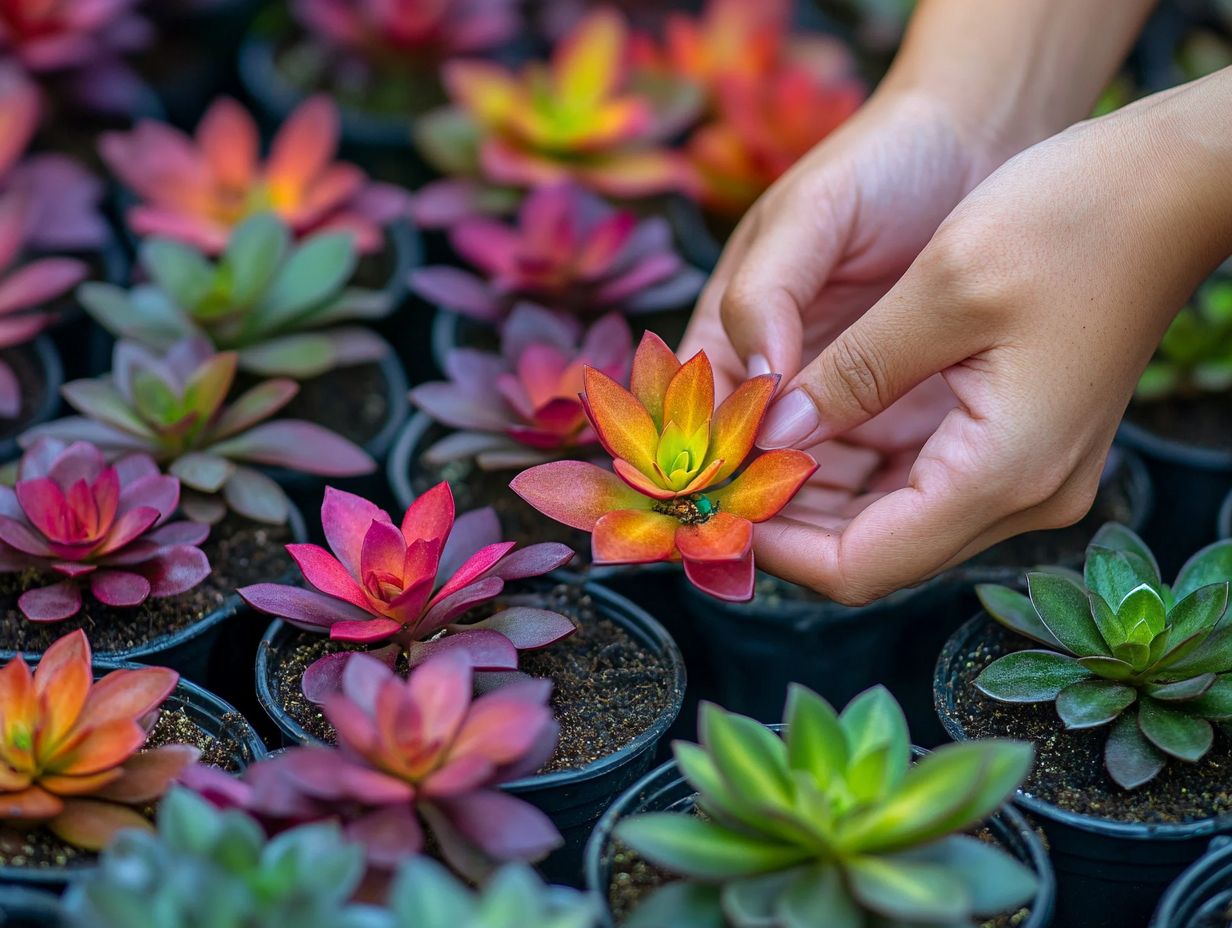
Offsets, or pups, offer a delightful opportunity to propagate Graptopetalum. These charming little plants emerge naturally around the base of the parent, making them easy to separate.
To determine which pups are ripe for removal, look for those that stand at least a few inches tall and have their own roots. For detailed guidance, check out how to propagate peperomia plants. Gently twist or use a sharp, sterile knife to cut them away from the parent, minimizing any damage.
When you’re ready to transplant, select a well-draining soil mix. Newly planted pups should be watered sparingly to avoid root rot, whether they find their home indoors or outdoors. Position them in a bright spot with indirect sunlight for optimal acclimation and growth. If outside, provide some shelter from the harsh afternoon sun. For those looking to expand their collection, check out this guide on how to propagate ZZ plants.
Preparing for Propagation
To prepare for the successful propagation of Graptopetalum, gather the right supplies and tools. Understanding the ideal conditions for healthy new growth is crucial.
Supplies and Tools Needed
Have the right supplies and tools ready think well-draining soil or cactus mix, pots, and sharp cutting tools.
These elements ensure that the propagation process unfolds seamlessly and results in thriving new plants. Well-draining soil prevents water from accumulating around the roots, which can lead to unsightly rot. Using pots with drainage holes allows excess water to flow away, further mitigating the risk of overwatering.
Sharp cutting tools, like scissors or shears, facilitate clean cuts on the plant, reducing damage and enhancing successful growth. By having these tools prepared, you create the ideal environment for robust root development.
Timing and Ideal Conditions
Timing and optimal conditions are essential for the successful propagation of Graptopetalum. Spring and summer are the most favorable seasons for growth.
During these warmer months, the plant enters its active growth phase. This is the perfect opportunity to take cuttings and encourage them to establish roots. To learn more about this process, check out how to propagate rubber plants. Make sure the temperatures stay between 70 F and 85 F (21 C to 29 C) for the best results!
Bright, indirect sunlight is vital for stimulating growth without scorching those delicate leaves. Additionally, maintain a well-draining soil mix; excess moisture can compromise root development. For those looking to learn how to propagate your favorite houseplants, monitor humidity levels closely. Moderate humidity supports healthy propagation; too much can lead to rot, while too little may stifle growth altogether.
Step-by-Step Guide to Propagation
This comprehensive guide to propagating Graptopetalum presents essential techniques. These will enable you to achieve the highest success rate while ensuring optimal plant health throughout the entire process.
Instructions for Each Method
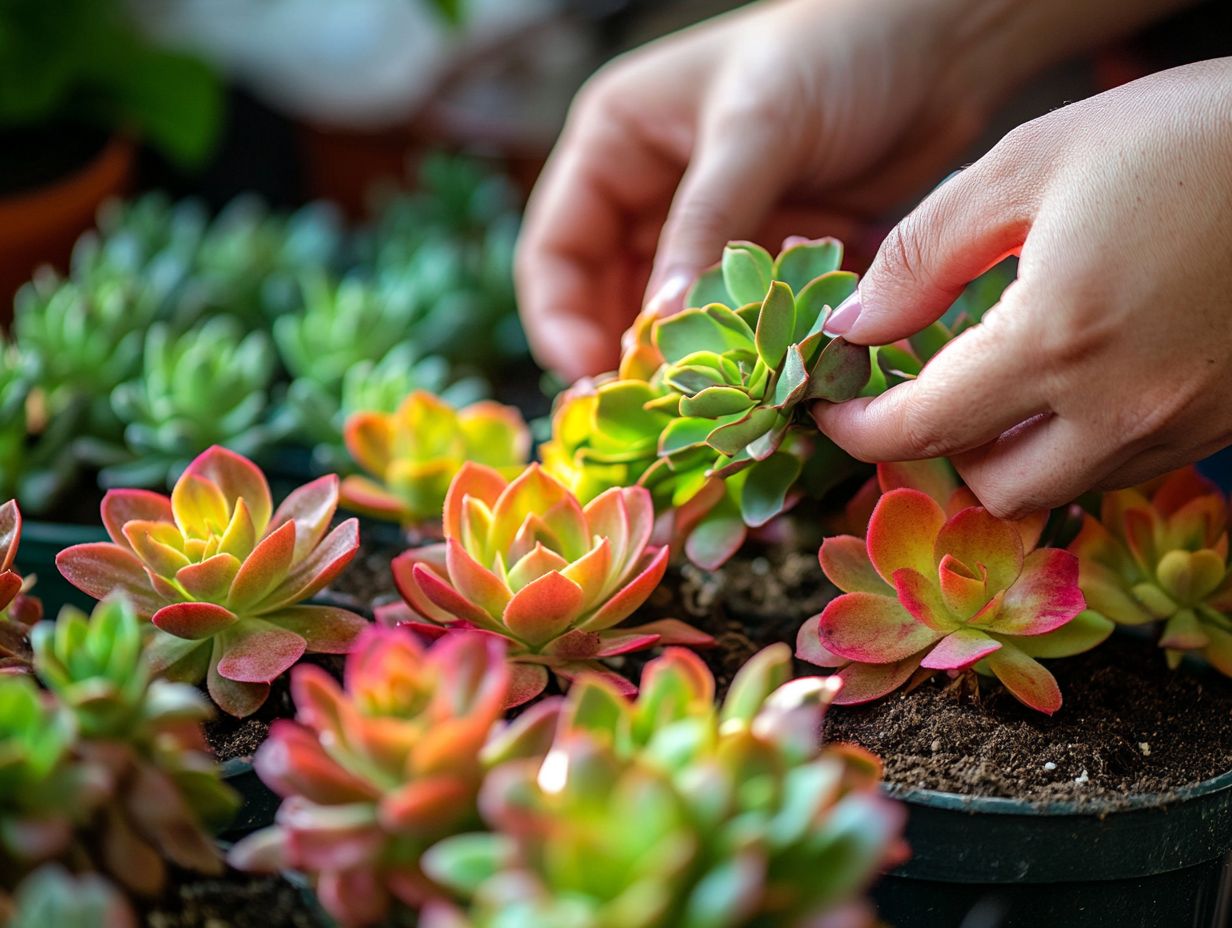
For each propagation method leaf cuttings, stem cuttings, and offsets (small plants that grow from the base of the parent plant) it’s essential to follow specific instructions closely to maximize your chances of success.
By grasping the nuances of each technique, you can significantly elevate your gardening experience and cultivate vibrant new plants! When working with leaf cuttings, be sure to select only healthy leaves and make clean cuts to prevent rot.
For stem cuttings, choose healthy, mature stems and place them in a well-draining medium. Avoiding excess moisture is key to steering clear of fungal issues.
Regarding offsets, gently detach them from the parent plant while ensuring that the roots remain intact. Keep a regular eye out for pests and diseases, and remember: it s far better to underwater than to overwater. This approach encourages robust root development while protecting your plants from soggy conditions.
Caring for Newly Propagated Graptopetalum Plants
Having successfully propagated Graptopetalum, your next focus should be on providing exceptional care for your newly rooted plants. This involves a thoughtful approach to transplantation, along with maintenance tips that will ensure their overall health and vitality.
Transplanting and Maintenance Tips
Transplanting your newly propagated Graptopetalum plants requires a delicate touch to ensure they flourish. Consistent maintenance tips will help keep them thriving.
Start by selecting a potting mix that enhances drainage, as Graptopetalum thrive in well-aerated environments. A blend of cactus soil mixed with perlite or sand will create the perfect medium for success.
When it’s time to transfer the plants, gently loosen the roots without causing any damage and make sure the new pot allows for adequate airflow.
Once you’ve placed the plants in their new homes, resist the urge to water them immediately. Allow them to acclimate for about a week before introducing water; this step will help prevent root rot. During this acclimation phase, provide indirect sunlight for several days, gradually increasing their light exposure. Keep a careful eye on them for any signs of overexposure or drought, ensuring they adapt smoothly to their new environment.
Troubleshooting Common Issues
Troubleshooting common issues that arise during the care of your Graptopetalum is crucial for maintaining its vibrant health and longevity. Overwatering, root rot, and pests can threaten your plant’s health, so addressing these concerns promptly will ensure your plant thrives beautifully.
Identifying and Addressing Problems
Identifying and addressing problems is essential for maintaining the health of your Graptopetalum, as issues like overwatering and common pests can significantly impact the vitality of this succulent.
Regularly monitoring your plant’s environment and condition allows you to catch potential problems before they escalate. For example, overwatering often shows up as yellowing leaves or a mushy texture, signaling that the roots may be struggling.
Root rot typically comes with a foul smell or blackened, slimy roots. Be vigilant for pests such as mealybugs and aphids, which tend to hide in the leaf joints.
By implementing solutions like adjusting your watering schedule, ensuring proper drainage, and treating infestations with natural insecticides, you can make a significant difference. Ultimately, consistent care and observation are key to ensuring that your charming succulents thrive.
Watch this video to learn more about how to propagate succulents successfully and taking care of your Graptopetalum plants!
Frequently Asked Questions
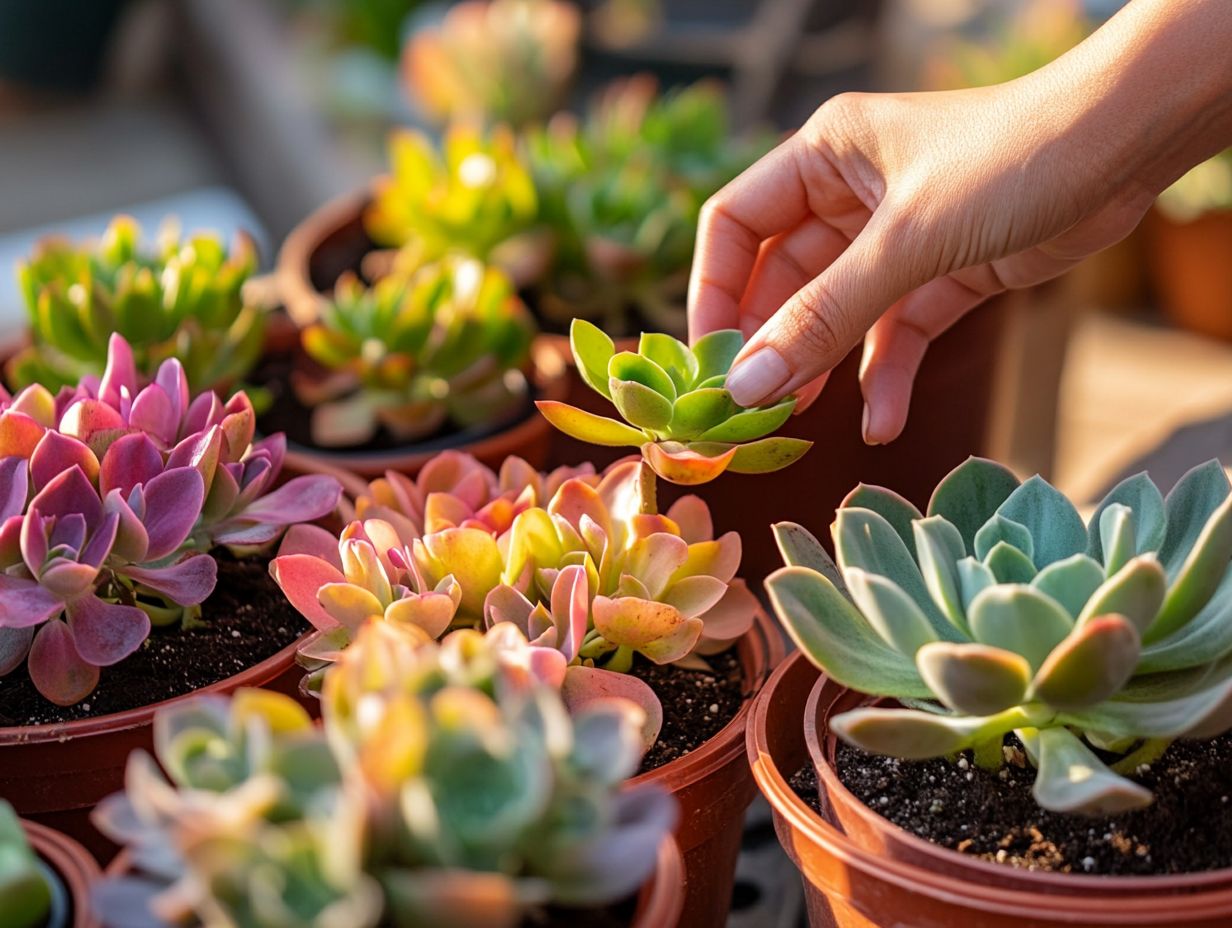
What is the best time of year to propagate Graptopetalum plants?
The best time to propagate Graptopetalum plants is during the spring or early summer months when the plant is actively growing and has the most energy to put into producing new roots and leaves.
Ready to give it a try? Start propagating your own Graptopetalum plants today!
What is the easiest method for propagating Graptopetalum plants?
The easiest way to grow new Graptopetalum plants is by using stem cuttings. Just cut off a healthy stem from the parent plant and place it in soil to root.
Can Graptopetalum plants be propagated from leaves?
Yes! You can grow Graptopetalum plants from individual leaves. Simply remove a healthy leaf, let it callous over, and then place it in soil to root.
How long does it take for Graptopetalum cuttings to root?
Graptopetalum cuttings usually take 2 to 6 weeks to root. Be patient and avoid over-watering; this helps your cutting thrive.
Should I use rooting hormone when propagating Graptopetalum plants?
You don t need rooting hormone for Graptopetalum plants; they root easily on their own. However, some gardeners use it to boost success rates, especially with more challenging methods.
Can Graptopetalum plants be propagated in water?
Yes, but it s not recommended. Propagating in water increases the risk of root rot. Rooting directly in soil is the best way to ensure healthy plants!

